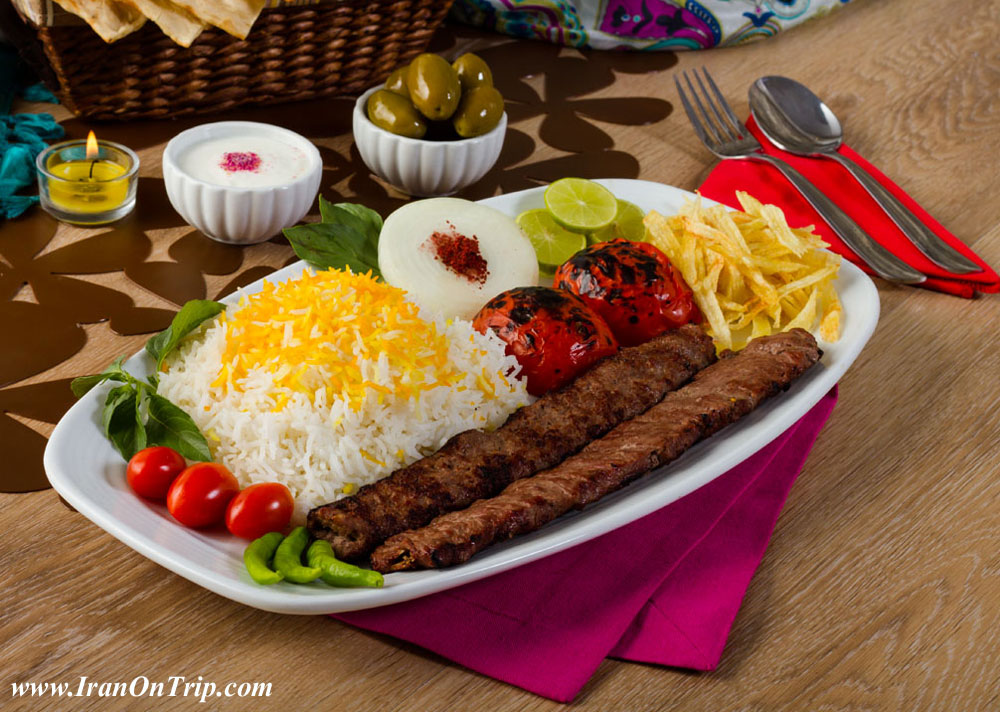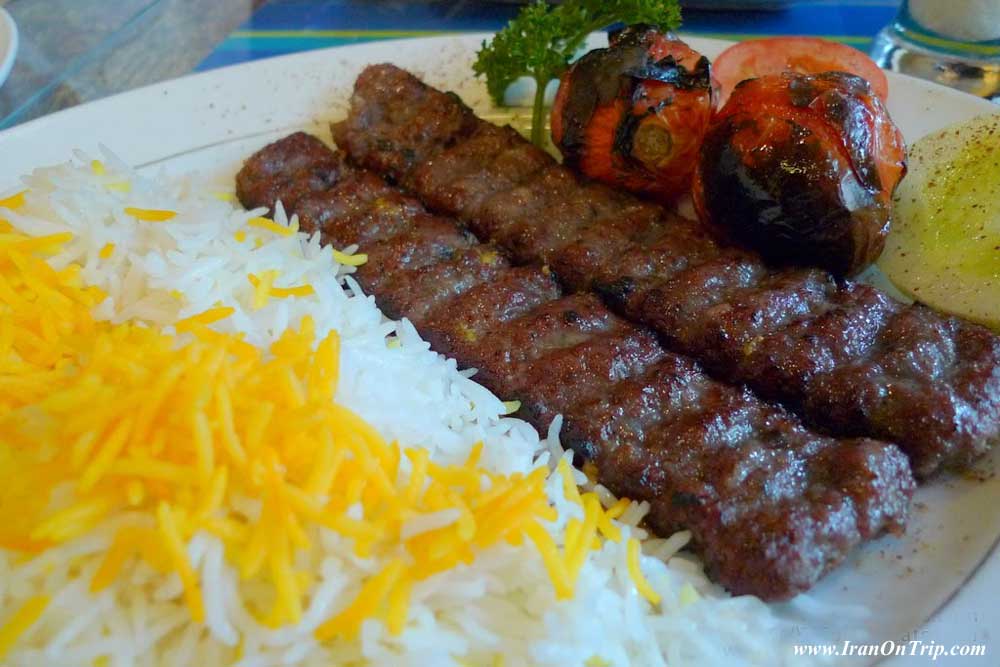Chelo-Kabab(Kabab Koobideh): The National Dish of Iran

Chelo-Kabab or Chelow Kabab is the national dish of Iran. The meal is simple, consisting of steamed, saffroned Persian rice and kabab, of which there are several distinct Persian varieties. This dish is served throughout Iran today, but was traditionally associated with the northern part of the country.
Chelo-Kabab is served with the basic Iranian meal accompaniments, in addition to grilled tomatoes on the side of the rice, and butter on top of the rice. Somagh (powdered sumac) is also made available, and can be sprinkled on the rice. It is an old north-western tradition (probably originating in Tabriz) that a raw egg yolk be placed on top of the rice, though this is strictly optional and no longer common. In fact, unless specifically requested, most restaurants will not serve the rice this way due to safety concerns surrounding the consumption of raw eggs.
In the old bazaar tradition, the rice (which is covered with a tin lid) and accompaniments are served first, immediately followed by the kababs, which are brought to the table by the waiter, who holds several skewers in his left hand, and a piece of flat bread (typicallynān-e lavāsh) in his right.
A skewer is placed directly on the rice and while holding the kabab down on the rice with the bread, the skewer is quickly pulled out. With the two most common kababs, barg and koobideh, two skewers are always served. In general, bazaar kabab restaurants only serve these two varieties, though there are exceptions. A combination of one barg and one koobideh is typically called a soltani, meaning "for the sultan".
The traditional beverage of choice to accompany Chelo-Kabab is doogh, a Persian sour yogurt drink, flavored with salt and mint, and sometimes made with carbonated water.
In their writings about Iran, the European explorers who visited Iran during Safavi era (1500-1736), though mentioned a lot about different kinds of chelos (cooked and drained rice) and polos (cooked rice), stews, pickles, and jams, but wrote nothing about Chelo-Kabab in the sense that we talk about it today.
Most probably the recipe of Chelo-Kabab has been given to the Iranian people either by the Caucasian people or by the Iranians visiting the region, or as written by Mirza Mohammad Reza Mo'tamed-ul-Ketab Shams Larijani, an author of Qajar era, has been demanded by Naser-e-Din Shah himself from the Caucasians and soon learned by Iranians all over the country.
Writing about Naser-e-Din Shah, Doust-Ali Khan Mo'ayer-ul-Mamalek, a descendent of the Shah, narrates that on Fridays whenever he wished to pilgrim the holy shrine of Hazrat Abdul-Azim in Shar-e Rey, then a village in the south of Tehran, his servants used to rush to the village one day earlier and order 1,000 to 2,000 kabab kubideh. Kabab was a dish not in the court menu but loved by his wives.
Thus, whenever they planned to go there, they did not want to lose the chance to have kabab served with basil, onion, and spring onion on copper platters.
Nayeb Chelo-Kabab Restaurant was the oldest one established in the Tehran bazaar 120 years ago. Since its establishment till some 15 years ago when it was closed down, to please the customers, Nayeb waiters used to serve the extra-filled plate of pyramid-shaped hot rice crowned with the melting butter while kababs on skewers were served by a waiter who used to go from one table to another and provide customers with extra kababs as soon as they ran out of them and as long as rice was still left in their plates.
First, the customers used to sit on bunches but later they were served at tables. The restaurant did not mind how many kababs a customer would eat and used to charge everybody the same, a generous manner that was characteristic of Iranians at that time, because of which it managed to run a brisk business.
In 1875, when Nayeb-Gholamhossein (the grand Nayeb) and his family moved to Tehran, he bought a public bath, located at the beginning of “Bazar-e Sahhaf-ha” (the bookbinders’ market). He filled the bath’s reservoirs and furnished the large area of the bath with brocade carpets and made a pleasant environment to let the businessmen taste his recipe of rice, butter and kabab, for the first time.
Nayeb’s innovative recipe obtained such a reception, that nowadays chelo-kabab is known as the national cuisine and “Nayeb” is a leading brand name in the food industries. Since 1875 five generations of the old family have successively passed a costly plan on preparing and offering the national cuisine of Iran with the highest possible levels of any category, in order to act as (authorized) Nayeb chelo-kabab restaurants, in compliance with the food standards of their own time as well as the taste of Iranians.
Iranian Chelo-Kabab Recipe

The rice is what everyone went crazy for in this dish. Chelo starts as a plain rice pilaf, but it's very buttery and it's made so that a crunchy golden crust forms on the bottom of the pot. Everyone wants a bite of the crust, but it's traditional in Iran to offer the crust to your guest.
Fresh onion juice is used to give the meat marinade a richer aroma than that of chopped onions. Saffron makes the Kabab elegant, but if you can't get saffron, substitute 2 teaspoons ground cumin and 2 tablespoons ground coriander. Made with saffron, the marinade is also excellent with chicken and fish.
1 3/4 cups fragrant long-grain white rice
Water
Salt
1/3 cup melted unsalted butter
Rinse rice in three changes of lukewarm water. Soak rice in cold water to cover with 1 1/2 tablespoons salt 1 hour.
Put 2 quarts water in pot, add 1 tablespoon salt and bring to boil. Drain soaked rice and add to boiling water. Boil until rice is nearly done but not soft, 5 to 10 minutes, stirring twice to keep grains from sticking together. Drain rice in colander and rinse with lukewarm water.
Put 1/3 of melted butter and 2 tablespoons water in bottom of pot. Using large spoon, sprinkle rice grains into pot, distributing evenly. Allow rice to form cone shape. Pour remaining melted butter over rice. With handle of wooden spoon, punch 2 to 3 holes from top of rice mound to bottom of pot.
Put dish towel or paper towels over pot, then cover with pot lid. Set pot on medium heat 10 to 15 minutes, then reduce heat to low 35 to 40 minutes. Can be kept in warm oven 1 hour.
KABAB
5 large onions
1/8 teaspoon saffron threads
2 pounds boneless lamb or beef, in Kabab pieces
Salt, pepper
1/4 cup butter, melted, optional
Cilantro
4 onions, quartered, optional
1 to 2 teaspoons ground sumac, optional
Quarter 1 onion and reduce to fine puree in food processor (leave kitchen windows open because of fumes). Push puree through fine strainer. Grind saffron to powder in mortar, or on plate using back of spoon, and dissolve in onion juice.
Clean meat and trim excess fat. Mix meat with onion juice marinade, cover with plastic wrap and marinate 1 hour at room temperature.
When ready to cook meat, season with salt and pepper to taste and thread onto skewers. Grill until done. Brush with melted butter.
To serve, set Chelo pot in sink of cold water 1 minute to loosen crust on bottom of pot. Remove pot lid. Turn large serving plate upside-down and cover pot with it. Holding pot and plate tightly together, turn both upside-down. Rice should come out on plate. ٔemove pot. Divide crust among diners and serve rice with Kabab. Quarter remaining onions. Garnish with cilantro and raw onions, and sprinkle Kabab with sumac.
Compiled By: Firouzeh Mirrazavi
.....
.....
.....

.jpg)



























